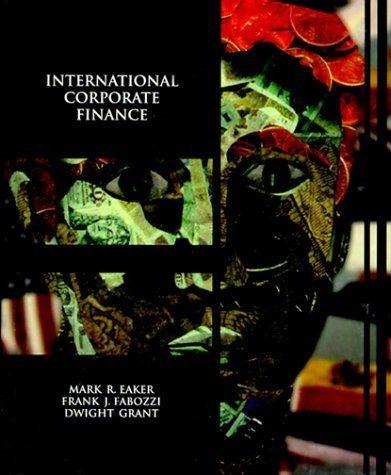Question
The Dark Star Savings Bank is a small savings bank operating in Dark Star, Colorado. Eleanor Swanson, CEO and President of Dark Star Savings Bank
The Dark Star Savings Bank is a small savings bank operating in Dark Star, Colorado. Eleanor Swanson, CEO and President of Dark Star Savings Bank is very concerned about the volatility in the bank's net interest margin. She has talked with other bank presidents, and they have mentioned to her that it might be better for the bank to use other measures of interest rate risk, in addition to a funding gap analysis, including a duration gap measure.
Ms. Swanson asks Bud Fogerty to incorporate duration analysis as an interest rate risk measure. She would also like a summary of the advantages and the limitations of duration analysis and funding gap analysis, and the risk return tradeoff between perfect hedging and a bank's NIM.
Bud Fogerty would like you to take on this task. As a start, he would like you to work with a simple balance sheet and train the other managers in the bank on the concept of duration, how it is calculated for each asset and liability, how duration changes with a change in interest rates, and how the bank's equity value and net interest margin are affected by changes in interest rates. He asks you to examine different scenarios for the bank with a positive duration gap versus a duration gap close to zero.
To help you with this task, Mr. Fogerty has prepared an initial hypothetical balance sheet for the following simplified bank with information on the cash flows, maturities, and annual percentage rates that you need in order to calculate the duration of individual assets and liabilities and the bank's duration gap. He has also prepared a list of questions for you to help you in your analysis.
In your discussion of the limitations and benefits of duration analysis, Mr. Fogerty would like you to keep in mind the fact that a duration gap assumes an equal change in the rates on both assets and liabilities (i.e., a parallel shift in the yield curve). If this is not the case, a zero duration gap, for instance, may not completely protect the value of a bank's equity. Also, since duration is a function of market rates, duration must be closely monitored, since it will change each time a change in rates occurs.
Balance Sheet for a Simplified Bank
| Assets | Liabilities |
| Cash $ 100,000.00 | Transaction Deposits $ 400,000.00 |
| U.S. Gov. Securities 190,476.19 | Savings Accts. 176,000.00 |
| Fixed Rate Mortgage Loans 600,000.00 | Insured CDs 352,330.18 |
| Fixed Rate Commercial Loans 300.000.00 | Fixed Rate CDs 162.555.83 |
| - | Total Liabilities $1,090,886.01 |
| - | Equity 99, 590.17 |
| Total Assets $1,190,476.19 | Total Liabilities & Equity $1,190,476.19 |
Information on Individual Assets
(1) The U.S. Government Securities are discount securities with one year to maturity. The maturity value is $200,000, yielding an annual compound rate of 5.0% .
(2) The Fixed Rate Mortgage Loans are amortized loans with 10 years to maturity. The annual payment for the loans is $88,251.58 which is paid at the end of each year. The annual compound rate for the loans are 7.71 % .
(3) The Fixed Rate Commercial Loans are structured to pay interest only each year, and a maturity value of $300,000. The maturity is 3 years. The annual compound interest rate is 6.71 % .
All assets are issued at current market rates, so the values on the current balance sheet are market values.
Information on Individual Liabilities
(1) Transaction and Savings Accounts have no maturity.
(2) Insured Certificates of Deposits (CDs) have one year to maturity. They pay interest and principal at maturity or $375,619.20 at maturity, providing an annual compound rate of 6.61 % .
(3) Uninsured Certificates of Deposits (CDs) have five years to maturity. They also pay interest and principal at maturity, with a maturity value of $235,658.27, providing an annual compound rate of 7.71 % .
Bud Fogerty asks you to answer the following specific questions.
a. Explain to the other bank managers the concept of a bank's duration gap and how it differs from a bank's funding gap.
b. Calculate the bank's duration gap. Given this gap, what is the likely expected change in the market value of the bank's equity if rates rise by 1%.
c. Calculate
i. the expected net income
ii. the net interest margin based on the current market values for the assets and liabilities and the annual compound yields (rates) that are given .
iii. the bank's one year funds gap
iv. the expected change in net interest income and the expected NIM with a 1 % rise in rates based on this fund gap.
d. How can you achieve a duration gap closer of zero? What is the implied effect on the bank
Step by Step Solution
There are 3 Steps involved in it
Step: 1

Get Instant Access to Expert-Tailored Solutions
See step-by-step solutions with expert insights and AI powered tools for academic success
Step: 2

Step: 3

Ace Your Homework with AI
Get the answers you need in no time with our AI-driven, step-by-step assistance
Get Started


